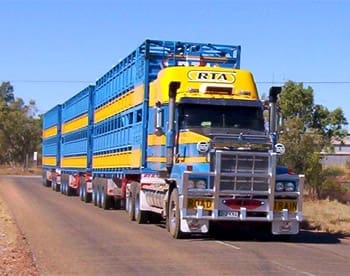 A surge in cattle transport activity on Queensland’s rural highways has been visible in recent weeks as producers move to destock cattle into feedlots and take advantage of a recent increase in live export orders to Indonesia.
A surge in cattle transport activity on Queensland’s rural highways has been visible in recent weeks as producers move to destock cattle into feedlots and take advantage of a recent increase in live export orders to Indonesia.
The feedlot sector’s latest quarterly ‘cattle on feed’ report released on Monday indicated that feedlot occupancy levels fell in the final three months of 2017 to 75 percent, down from 80pc three months earlier.
However, reports of mass cattle transport activity from Queensland’s dry west and north into southern feedlots suggests the next quarterly report is likely to show an increase again.
Livestock transporters have also reported a sharp recent upturn in demand to transport cattle from Cloncurry to Darwin for live export orders.
Road Trains of Australia is one of the country’s largest livestock transporting companies, servicing just about every corner of Australia’s north.
After a very quiet 2017, impacted by a downturn in live export orders and the generally tight supply of cattle, the company’s phones have been ringing hot since the start of February.
RTA’s Queensland operations manager, JR (John) Rogers, based in Longreach, is usually office bound, but has returned to the wheel for the past two weeks helping to manage the recent surge in demand.
When Beef Central spoke to JR on Tuesday he had just delivered cattle from north western Queensland to a feedlot on the Darling Downs.
“It has just gone crazy, in the last week the telephone hasn’t stopped,” he said.
“The cattle trucks I have seen on the road in the last couple of days, trucks you don’t normally see in this country (the Darling Downs), it is just a continuous flow of cattle.”
He said it was clear from the amount of activity that a lot of producers had drawn a line in the sand at the start of February, and having received no rain by that stage, had decided it was time to act and destock.
“They are just going everywhere,” he said. “There is no area that is not trying to lighten off.
“The channel country is starting to get really bad, and on the lower side of the Barkly it is really dry, and a lot of them are coming to feedlots on the downs.”
Transport activity from Cloncurry to Darwin for live export had also returned to its strongest levels in over a year.
Cattle exports from Darwin in 2017 totaled 287,221, down from 355,656 in 2016.
However the 2018 year appears to be off to a flying start, with 30,000 cattle exported in January, more than double the volume of January 2017. Three cattle ships have loaded cattle in Darwin in the past four days.
The surge in export activity stands in stark contrast to the well-documented challenges to demand for live cattle in Indonesia, largely through competition from lower priced imported frozen buffalo meat from India.
One livestock export industry source suggested to Beef Central the increased cattle export activity was being driven by a combination of dry conditions in Queensland and short-term demand for feeder steers to feed for 100 to 120 days in time for the Ramadan/Labaran religious festivities in Indonesia in June/July 2018.
With an increase in cattle supply likely to occur after the wet season, and the general demand environment reportedly still quite negative, the big question is whether supply may override demand in 2018, a dynamic the trade has not seen for over two years, which has helped prices to remain high for the past two years.



HAVE YOUR SAY